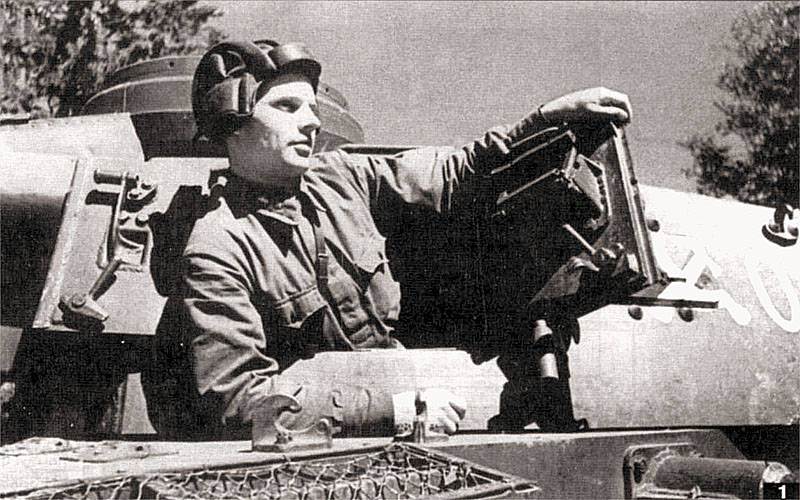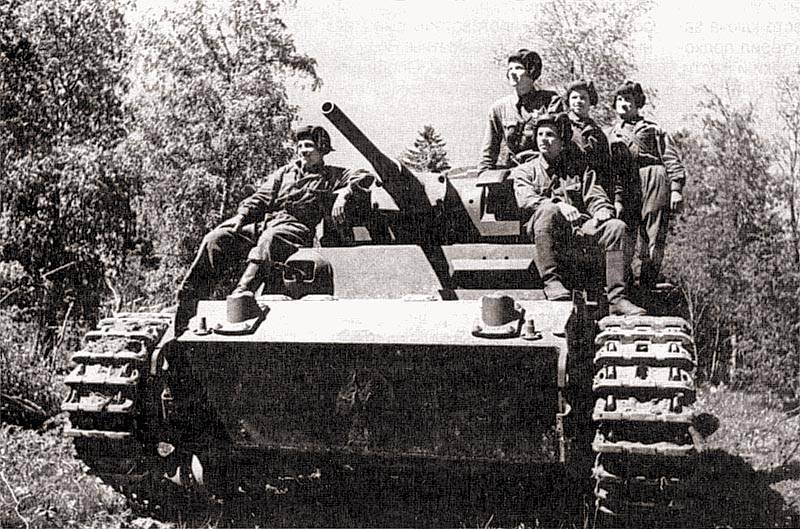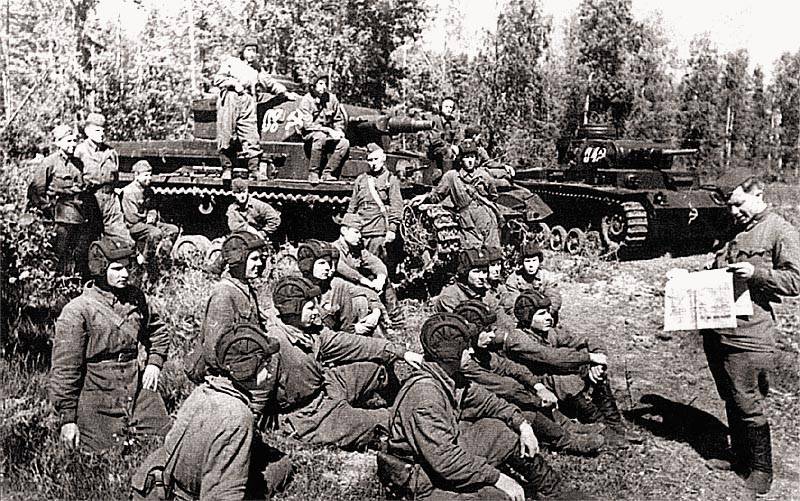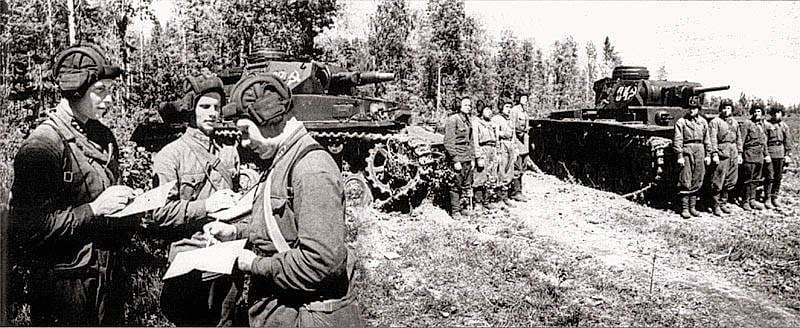Taken from under fire

At the beginning of April, the 1942 of the 1 th separate mountain rifle brigade, the 80 th rifle division and neighboring units were to attack Venyagolovo. To break through the line of enemy defense and infantry support tanks were needed. And after the February battles of Pogostiya, tanks in the local sector of the front were not enough. 124-I and 122-I tank brigade missed many vehicles, and could not even with the full composition to provide part of the two advancing armies. 107-th separate tank battalion was completely without cars. At the end of March, the tank crews of this battalion languished from forced idleness in Olomn, near the army headquarters, and felt disgusting. But where was the new car coming from? In the second half of March, the Ladoga ice under the spring sun was already melting and collapsing, the ice track was about to close, transport the tanks from Leningrad, as it was done in winter, now turned out to be impossible. New tanks from distant rear plants, it must be assumed, were more necessary in other places.
Tankers of the battalion and its commander, Major B.A. Shalimov, decided to get the tanks themselves - to look for padded German vehicles in the woods for Pogogem, to restore which ones it is possible to use them.
Deputy commander of the Leningrad Front, Major General Bolotnikov, approved the idea of tankers.
... Five people — senior sergeant N.I. Baryshev, rank 2 military technician, I.Pogorelov pomtekhrota, Skipkov and Belyaev, mechanics-drivers Skachkov and Belyaev, and with them a sandpuffler Komsomol member Valya Nikolayeva, who studied the tower gunner specialty, were sent to search wrecked tanks.
On the first day, the group, moving to the front line, did not find anything in the forest. We spent the night under the tree, in the snow. On the second day, southwest of Pogostya, the group approached the front line. They walked through the forest, under gunfire and mortar fire, but did not pay attention to him - everyone is accustomed to this!
And now, it seems, good luck! Thanks to the infantry - I did not lie: in front, between the trees, two medium German tanks. Hurried to them ...
But what were these tanks! One is completely defeated by the direct hit of a heavy projectile. weapons, the crushed engine was lying about fifteen meters from the side clutches, the gearbox was sticking out of the snow in the other side, armor ragged rags covered miraculously surviving a mighty pine, broken down, but only slightly crooked. Small details were scattered over a radius of at least fifty meters. Among the wreckage of metal, in the snow-covered with blood of blood, lay the corpses of Hitler's tank crews.
There was nothing to do here, except to notice what details might be useful in repairing other tanks that had not yet been found.
The second tank was not far from the remnants of the first. But it was not suitable for restoration either: half of the turret, shot down by the projectile of our anti-tank gun, lay on the ground. However, it was worthwhile to tinker with him, at least for practice - it could probably have been started, no damage in the motor was found.
None of the five reconnaissance aircraft of the German tanks knew, and therefore, still not paying attention to heavy artillery and mortar fire, everyone began to study an unfamiliar system.
From noon until late at night, Baryshev, Pogorelov, and the rest were carried by these two tanks.

Analyzing the knots broken by shrapnels, comparing them with the survivors on the second tank, friends learned a lot of useful things that day. Valya was especially pleased: Pomtelov Pomtehov had long ago promised to teach her how to drive a tank and a motor. Not for her age to be a nurse in the 107-th separate tank battalion, although everyone knows that she did not fail in this matter, the medal "For Courage" was given to her in Nevskaya Dubrovka!
At dawn on the third day we decided to continue the search. Baryshev glanced at the compass - and, again walking ahead, led everyone strictly to the south-west, in the direction indicated two hours ago by a counter artillery-spotter. The crackling of a rifle-and-machine-gun exchange, which was now heard with complete clarity, with the clarity that only happens in the forest in the freezing air, confirmed to Baryshev that the direction was correct. But the forest was still empty, except for the nazis and ordinary corpses scattered everywhere. traces of the battle that took place here a few days ago.
The whole group stopped, peering into the thicket of sun-drenched snow forest. Between the mighty pines, above the spruce low forest, not far from the outskirts guessed behind it, where, undoubtedly, the advanced trenches of the Germans were passing, the greenish-gray tank tower was barely visible.
After consulting, all five of them moved along a clearing, but they did not go even a hundred steps, as were stopped by the sentinel that advanced from behind the pine trunk. After exchanging a pass, a response, we listened: “Then, comrade military technician, you can't go, the Germans are two hundred meters here! .. And the tank, indeed, is a German tank, it’s already a week on our site ... we tidied it with grenades! ..”.
Baryshev and Pogorelov did not have time to finish the conversation with the sentinel, as everyone immediately had to heal, - obviously, having heard the conversation, the Germans fanned out the machine-gun fire along the glade ... And, only after looking into the skylight outside the forest, Baryshev saw snow bumps of the dugouts and a small trench drowned in long snow drift parapet. Our soldiers did not respond to the enemy’s machine gun fire. With a gesture of his hand, Pogorelov ordered his group to crawl to the tank. This solid German tank rolled over through our defensive line, managed to enter the forest, but right there at the edge and finished its combat path.
Noticing the people crawling up to the tank, the Germans made frequent machine-gun shots so that, buried in the snow, we were forced to lie down. Then, choosing the seconds between the queues, listening to the energetic automatic rifle-shooting, ours, all five, crawled from snowdrift to snowdrift and from pine to pine, got close to the tank and lay down behind it. The starboard he was turned in our direction, and his side hatch was open.
Having seized the moment, Pogorelov and Baryshev were the first to jump on the caterpillar. We climbed into the hatch. The Germans immediately showered the tank with machine-gun fire. Almost simultaneously, three mines slammed in front of the tank one by one. Pogorelov appeared in the hatch, waved his hand. Valya Nikolayeva and Belyaev managed to get into the tank before the next mortar volley, and the foreman Skachkov lay down between the tracks, under the car.
Inside the tank there was chaos, caused by grenades exploding there. Control levers were broken, the entire control system is broken. From the German crew, killed and thrown out of the tank (the corpses lay right there, close to the car), there were only icy blood stains ...
After making sure that the five people who had reached the tank were invulnerable, the Germans stopped the mortar and machine-gun fire. Baryshev looked at his watch - the arrows showed exactly noon. Now you can get down to business. The foreman Skachkov also climbed into the tank and laid out the tools collected the day before in the broken machine, the same type as the machine. Revised everything, went through the torn thrust, made sure that in the cooling system antifreeze, and not water, and therefore the radiator is intact. Valya helped throw everything that was deemed unnecessary out of the tank.
And then the repair began ...
It lasted for many hours. Instead of a thick wire, fragments of a cable, yesterday's study of a broken tank helped everyone. The power supply system damaged by splinters was patched with pieces of copper from straightened sleeves. Viewed all the electrical equipment, fixed the torn wiring, tried all the valves, starter, turned the pump. There were no machine guns in the tank, but now it didn’t matter - it was important to start a tank and steal it from the shelling zone. Instead of an ignition key, Baryshev made a suitable hook from wire and tin. On the eve of the most difficult was to understand the scheme of electrical equipment - mastered by conjecture, and now the acquired knowledge is useful. They sent Belyaev and Skachkov to the infantry in the trench for fuel, they ran to the artillerymen, after a couple of hours and a half they dragged several jerry cans, again there was a machine gun fire, and again everything turned out well.

Filled fuel in the tank. Baryshev decided to try to start the engine, pressed the starter button, the engine started up well, and immediately again started shooting, bullets clicked on the armor. Baryshev quickly inspected the gun, - it was with an electric fuse, which did not work and without which a shot could not be given. There was no time to sort out the electrical winding and fix it - the Germans opened fire with mortars. Baryshev and Pogorelov loaded a fragmentation cannon, turned the turret towards the Germans, put it in and grabbed a piece of wire, attached one end to the driver’s shield, the other end joined directly to the end contact of the electric gun.
There was a shot. They gave him a second shot. Third. Machine gun and mortar firing stopped. It was possible to withdraw the car, but around it turned out to be a minefield. In the bands of snow melted under the March sun, anti-tank mines were visible here and there. But others might not be visible. Especially it was necessary to be afraid of snowdrifts and large pillows of moss. Everyone looked at each other. Baryshev’s eyes asked Belyaev: “Well, how?”. Belyaev, pressing his lips, shook his head in the affirmative. Baryshev waved his hand: "Come on!".
Belyaev unfolded the car - she listens! Then, boldly and confidently, but very carefully, Belyaev led the tank through a minefield, passing some mines between the tracks, others bypassing the close quarters, leaving aside the others. They were not located, as it should be, in a checkerboard pattern, but scattered as it should. This enabled Belyaev to maneuver. Small, anti-personnel mines under the tracks crackled like firecrackers — such a tank could not harm. The corpses of the Germans were lying around, and Belyaev led the tank over the corpses. Experiencing an unpleasant feeling, Belyaev frowned painfully, but it was the only way to reduce the risk of running into a mine, because a wounded, dying man, noticing that he fell on a mine, would hardly argue that this mine was anti-tank and, therefore, his small weight should not explode ... No, of course, and losing consciousness, he would try to slip away from her! .. However, the tank could have hit a mine, and it would have blown up under its tracks, but ... it was a matter of chance!
Not reaching ten meters from the clearing, the car stopped: the engine stalled. Looked: what's the matter? No petrol supply. Not knowing the design of the fuel supply system and trying to get out of here as soon as possible, we decided to make a siphon, but there were no hoses. Turned off the drain pipes, found a small piece of hose, put one end of the tube into the gas tank, and the other end, through the top of the motor, put it into the gas filter. Belyaev pressed the starter button, the motor started working ...
On the side of them, a second similarly captured tank unexpectedly rolled out. He was led by the commander of the company of their battalion, Senior Lieutenant Dudin and the company Commissar, Junior Political Commander Polunin. They saluted each other with joyful exclamations, volleys from rifles, pistols and, getting together in a circle in the cars, drank their breath in front of the march on a hundred grams of the cherished company of the company commander. From the German flag found in the box, which was prepared for the occupied countries, Valya tore out pieces of cloth, hastily sewed two red flags from them, approved them above the tank turrets: our anti-tank artillery was behind, and it was necessary that these flags were visible from afar.
And the car behind the car, with the large red flags flying above the open hatches, moved on together.
And the forest, forest, forest, driving five kilometers, rolled into the territory of SPAM - in a forest clearing, in the depths of the location of our troops.
Valya, Skachkov, Pogorelov sat on the armor of the tank for the last part of the way, Valya was waving a red flag in delight, and our infantrymen, artillerymen, fighters of various units across the road were shouting “Hurray!” To the same enthusiasm ...

These were the average German tanks PzKpfw III with square black crosses painted on the sides on armor on a white background. The Baryshev tank, with a large number over the 121 tracks, was released by the German military plant in February 1942 of the year and entered into the 107-th separate tank battalion 28 in March 1942 of the year, so that after a week of thorough repairs, it would join in with nine other trophy trophies tanks in the attack of our units on the German fortified site Venyagolovo, west of Pogostya, on the right bank of the Mga river, filled with the blood of many hundreds of people *.
That night, Senior Sergeant Nikolai Ivanovich Baryshev was appointed commander of the tank he had brought, Senior Sergeant Anatoly Nikitich Belyaev — his driver-mechanic, and the next morning the crew was fully staffed: Komsomol member, senior sergeant Ivan Fomich Sadkovsky, the gunner, appointed the commandant, Senior Sgt. a recent student, party candidate Evgeny Ivanovich Rastorguev and loaders - a private soldier, Komsomol member Georgy Frolovich Zubakhin.
Of all ten restored trophy tanks in the battalion, a third company was formed under the command of Senior Lieutenant Dudin.
Baryshev and the crew of his tank had to fight in the German rear, but no one had thought about this, had not wondered.
For the repair of the Baryshev tank, the commander of the battalion, Major BA Shalimov, gave the crew five days and five nights. It was necessary to replace six rollers with a balance bar, restore all electrical equipment and, of course, electric gun fuse, put the entire control system in order. The tank had no machine guns, a walkie-talkie and a telescopic sight **.
* The 107 documents of the separate tank battalion stated that “as of 1 on April 1942, nine captured tanks had been evacuated. One light tank is suitable for combat, the rest require equipment with weapons and optics. ” Information about the brands of captured machines are present only in the document from July 5 1942. At this point, 107 OTB had one KB, two T-34, one BT-7, two PzKpfw lll, one PzKpfw lV, three SAUs StuG III and one PzKpfw l - Approx. ed.
** Based on the book "Leningrad Acts", Moscow, "Soviet Writer", 1971.
Information